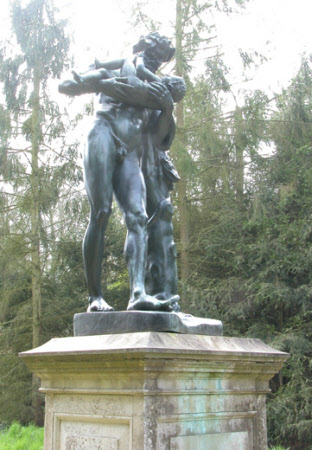Silenus with the Infant Bacchus
attributed to French School
Category
Art / Sculpture
Date
c. 1850 - 1900
Materials
Bronze
Measurements
2000 x 750 x 750 mm
Place of origin
France
Order this imageCollection
Anglesey Abbey, Cambridgeshire
NT 515152
Summary
Bronze, Silenus with the Infant Bacchus, probably French, mid to late 19th century, after the antique. A colossal bronze statue of Silenus, the teacher and companion of Bacchus, who is depicted as an infant in Silenus' arms. After the Roman marble now in the Louvre, Paris (MR 346; N280; Ma 922) which is believed to be a copy of a lost bronze attributed to Lysuppus or one of his followers. Silenus, nude, bearded, with a crown of grapevine and a boar skin draped over his proper left arm, cradles the baby Bacchus, looking tenderly towards him. Bacchus wriggles and reaches his proper left arm towards Silenus. The bronze with black patination and some green oxidisation. Mounted on a panelled stone pedestal.
Full description
The marble statue was discovered sometime before 1569 by Carlo Muti on his grounds near the present Cassino Massimo. It entered the Borghese collection in 1613 and remained at the Villa Borghese until 1807 when it sold by Prince Camillo Borghese to his brother-in-law, Napoleon I, and placed in the Louvre. The Silenus was classed among the greatest antique sculptures in Rome and frequently reproduced. A full-size bronze copy was cast in the 1570s for Cardinal Ferdinando de' Medici (Uffizi, Florence) and a plaster cast was made for Philip IV of Spain in 1650. A marble replica was made in 1684 for Versailles, joined a year later by a bronze copy by Balthazar Keller (MR 3291). Casts and copies continued to be produced well into the nineteenth century. A large bronze cast by Luigi Valadier (1726–1785) is in the ante-room at Syon House; see also the full-size bronze cast at Petworth House (NT 485298, attributed to the French School, 19th century). The cast was purchased in December 1950 by Lord Fairhaven from the statuary and architectural salvage dealer Bert Crowther. A letter from Crowther dated 22 November 1950 states that the Silenus 'came from the late Lord Melchet, Ireland House, Romsey'. It was sold by Henry Ludwig Mond, 2nd Baron Melchett (1898-1949) at the Colworth House sale of 1947 (lot 1303). Alice Rylance-Watson 2019
Provenance
Formerly in the collection of Henry Ludwig Mond, 2nd Baron Melchett (1898-1949), Colworth House, Sharnbrook, Bedforshire; sold Knight Frank & Rutley, 21 October 1947, lot 1303, 'An heroic size verde bronze figure of Silenus and the Infant Bacchus, 6ft. 9ins. high' (p.82); purchased Burt Crowther, Syon Lodge; purchased Urban Huttleston Rogers Broughton, 1st Lord Fairhaven (1896-1966) from Bert Crowther, 16 December 1950, with NT 515135 (The Olympian Courtship), NT 515159 and 515160 (Diana and Apollo), £1600; bequeathed by Lord Fairhaven in 1966 with the house and the rest of the contents.
Credit line
Anglesey Abbey, The Fairhaven Collection (The National Trust)
Makers and roles
attributed to French School, sculptor
References
Haskell and Penny 1981: Francis Haskell and Nicholas Penny, Taste and the Antique, The Lure of Classical Sculpture 1500 - 1900, New Haven and London, 1981, p. 307, no. 77 (fig 162). Oswald 1930: Arthur Oswald, 'Country Homes and Gardens Old & New: Melchet Court, Romsey, Hampshire, The Seat of Lord Melchett', Country Life, vol. 68, issue 1751, August 9, 1930, pp. 176-83. Roper 1964: Lanning Roper, The Gardens of Anglesey Abbey, Cambridgeshire. The Home of Lord Fairhaven, London 1964, pp. 25, 86, pls. 70, 73. Christie, Manson & Woods 1971: The National Trust, Anglesey Abbey, Cambridge. Inventory: Furniture, Textiles, Porcelain, Bronzes, Sculpture and Garden Ornaments’, 1971, p. 167.

